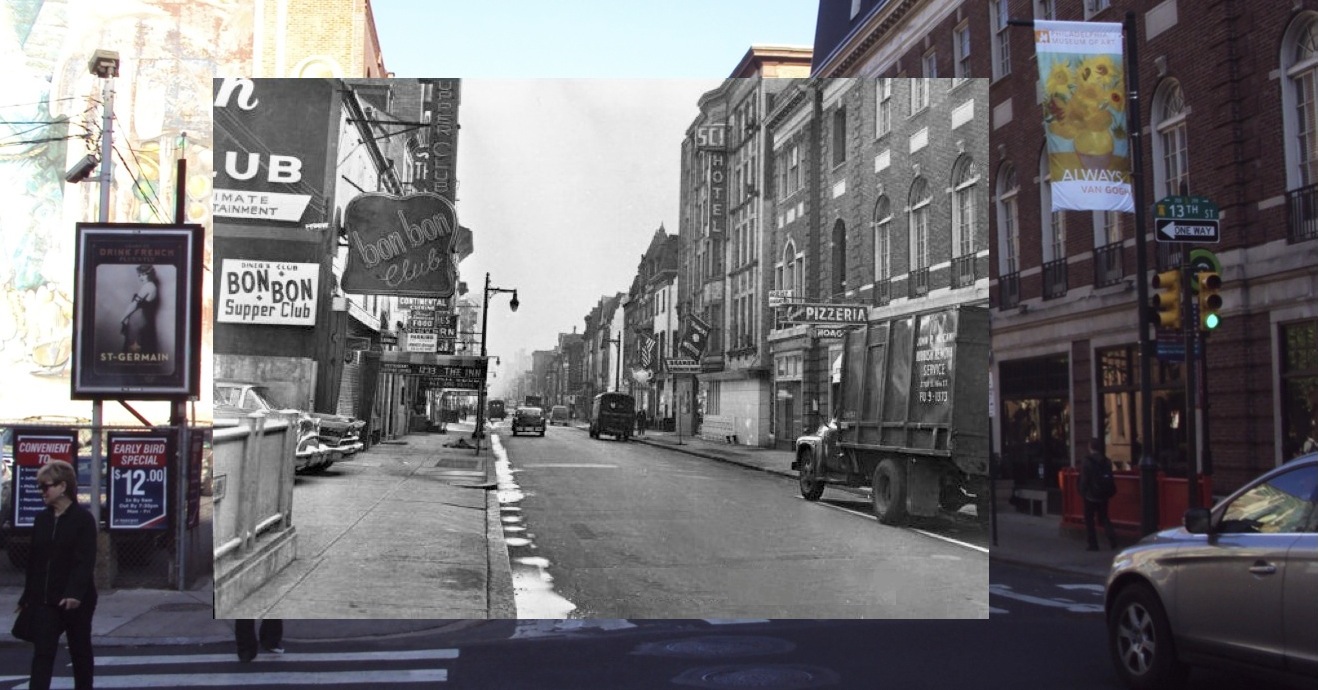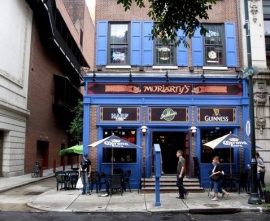Rusty’s: Where Were You in ’62?
by ilcorago
With this post we’re back on Quince and Walnut Streets, where today you can enjoy a fine burger and a Guinness at Moriarty’s Irish Pub, the former home of Philadelphia’s most famous lesbian bar – Rusty’s.
Although today we think of most of Walnut Street as a commercial thoroughfare, like most Philadelphia streets, it began as a residential area. By the 1890s, so many homes had been converted to shops that the city began removing all the stoops to the buildings on Walnut within a few blocks of Broad St. to make more room on the sidewalks for shoppers and to provide easier access to the businesses. Below is a photo of the south side of Walnut Street in February of 1927. Just a few months later, most of these buildings would be demolished and construction would begin on the Forrest Theatre. The ornate buildings on the far left were the Turkish and Russian Baths. More research needs to be done on the Turkish baths that served Philadelphia business men in the 19th and early 20th century and their place in the gay subculture. I’ve only come across one reference to them in a Vice Commission report in 1913, where a hotel bellboy tells the Commission that “now that there’s been a crackdown on prostitutes in the city, the fairies in the baths are getting bolder.” There is a lot more history to explore behind that quote.
* * *
QUINCE GOES THEATRICAL
The building with the white sign three doors down to the right at the southeast corner of Walnut and Quince, was the Davis and Harvey auction house. On the far right, at 1116 Walnut St., is the building where Moriarty’s now operates. It was home to the W.F. Jones tailoring business for the first few decades of the twentieth century.
When the Forrest Theatre was completed in 1928, it changed the tone of the neighborhood. Restaurants catering to the theatre patrons sprung up at 202, 204 and 211 S Quince St. (See the histories of the restaurants on S Quince St. in this blog archives under the Quince St. category.) In the late 1940s, the business became the Café Footlight. You can still see the old “Café Footlight” sign painted on the wall in the photo, left from 1958. By the time this photo was taken, the name had changed from the theatrical Café Footlight, to the very fifties Star Lite Café.
ENTER RUSTY
ENTER RUSTY
About 1963, the bar became known as Barone’s Variety Room. The main entrance to the restaurant and bar was on Walnut Street, but if you went around to the Quince St. side of the building, through the side door and up the stairs, you were in Rusty’s.
In November of 1967, Philadelphia Magazine published an article by Nancy Love called “The Invisible Sorority,” a semi-lurid exposé on Philadelphia’s lesbian community. The article opened with a visit to Rusty’s:
A small sign over the door on Quince Street, a little alley next the Forrest Theatre, says “Variety Room.” It’s very quiet as you go up the old wooden steps to the second floor and down the long corridor. You don’t hear the juke box until you’re actually in the room. You pay the $2 minimum to a woman in a white button-down shirt and slacks who looks a little like a gym teacher you once had, and she gives you a strip of tickets for drinks. It’s a smallish panelled room with a bar at one side and lots of tables clustered around a dance floor. At first, the relaxed atmosphere and informal dress and young girls make you think of a girls college hangout in a small town.
 The woman at the door in the button-down shirt might have been Rusty Parisi, owner of the bar. She is the woman in glasses on the cover of the Philadelphia lesbian feminist newspaper Wicce, above. This issue, published in 1974, featured an interview with Rusty and a nostalgic look back at lesbian life in the ’60s. Rusty was one of the first bar owners in Philadelphia who was gay herself. She discussed butch and femme roles, police harrassment and her own experiences. When asked how she felt about men in general, she replied bluntly, “I’ve never been with one and I’d never want to be. So that’s what I think of men in general. Not much.”
The woman at the door in the button-down shirt might have been Rusty Parisi, owner of the bar. She is the woman in glasses on the cover of the Philadelphia lesbian feminist newspaper Wicce, above. This issue, published in 1974, featured an interview with Rusty and a nostalgic look back at lesbian life in the ’60s. Rusty was one of the first bar owners in Philadelphia who was gay herself. She discussed butch and femme roles, police harrassment and her own experiences. When asked how she felt about men in general, she replied bluntly, “I’ve never been with one and I’d never want to be. So that’s what I think of men in general. Not much.”
The matches, above left, are from the cigarette machine in Rusty’s. With their 1960s pin-up girls and phallic rockets, (the one on the right is limp!), they are two of my favorite objects in the William Way Community Center’s archival collections.
THE RAID ON RUSTY’S
 On the night of March 8, 1968, a year after “The Invisible Sorority” appeared, women out for a drink at Rusty’s suddenly found the jukebox unplugged and the house lights brought up. It was a police raid. Under Police Comissioner Rizzo, raids on gay and lesbian bars were an all too common occurence in 1960s Philly. Many of the women were verbally abused; police accused them of being drunk and disorderly. Some were booked and held overnight. They were brought before a magistrate the next day, but all charges were dropped. It was a clear-cut case of police harrassment.
On the night of March 8, 1968, a year after “The Invisible Sorority” appeared, women out for a drink at Rusty’s suddenly found the jukebox unplugged and the house lights brought up. It was a police raid. Under Police Comissioner Rizzo, raids on gay and lesbian bars were an all too common occurence in 1960s Philly. Many of the women were verbally abused; police accused them of being drunk and disorderly. Some were booked and held overnight. They were brought before a magistrate the next day, but all charges were dropped. It was a clear-cut case of police harrassment.
 The local chapter of D.O.B. editorialized against the raid. D.O.B., the “Daughters of Bilitis,” was a national lesbian social and support organization with a policy of political non-involvement. The Philadelphia chapter was one of the exceptions. A few nights later, after another raid on Rusty’s, local activists Ada Bello, above, on the left, seated next to Frances Hanckel, right. Lourdes Barbara Gittings were present. When Police asked Gittings for her I.D., Barbara flashed her ACLU card. The police moved on.*
The local chapter of D.O.B. editorialized against the raid. D.O.B., the “Daughters of Bilitis,” was a national lesbian social and support organization with a policy of political non-involvement. The Philadelphia chapter was one of the exceptions. A few nights later, after another raid on Rusty’s, local activists Ada Bello, above, on the left, seated next to Frances Hanckel, right. Lourdes Barbara Gittings were present. When Police asked Gittings for her I.D., Barbara flashed her ACLU card. The police moved on.*
 In May, the D.O.B. arranged a meeting with the Philadelphia Police Inspector and they brought along an ACLU observer. The D.O.B. let the Inspector know that they represented the community and that they were were not afraid to protest violations. The police issued a statement that “homosexuals have been, are now, and will be treated equally with heterosexuals.” Because of their active support in the incident, membership in the Philadelphia D.O.B. increased dramatically. A year before the Stonewall riots, the raid on Rusty’s and the reaction of local lesbians was a success story for gay rights.
In May, the D.O.B. arranged a meeting with the Philadelphia Police Inspector and they brought along an ACLU observer. The D.O.B. let the Inspector know that they represented the community and that they were were not afraid to protest violations. The police issued a statement that “homosexuals have been, are now, and will be treated equally with heterosexuals.” Because of their active support in the incident, membership in the Philadelphia D.O.B. increased dramatically. A year before the Stonewall riots, the raid on Rusty’s and the reaction of local lesbians was a success story for gay rights.
● Matchbooks and cover of Wicce courtesy of the John J. Wilcox Jr. Archives at the William Way LGBT Community Center.
* Some details of this entry have been corrected on July 11, 2013, thanks to input by Ada Bello. Also, according to Ada, portrait artist Susan Schary painted several of Rusty’s patrons, Lourdes Alvarez and Ada Bello among them, as well as Rusty Parisi’s. The whereabouts of the latter is not known.
Thank you, Ada!







[…] The “Gayborhood” in Philadelphia is an area in the city centre, within Washington Square West and the surrounding blocks, where rainbow colours mark the street signs. This blog details the neighbourhood’s history. It’s written by a local tour guide, with 14 years’ experience, who also happens to be the president of the Association of Philadelphia Tour Guides. Although some reports show say that the area has become a victim of its own success, this blog is still going strong.Useful post: why there is more to this Irish pub than meets the eye […]
Thanks. Another reason to to be proud to be gay in Philly.
What a nice thing to say!
Went to Rusty’s a few times in the early 1970s. Nice place, good vibes.
Thanks for sharing that, Gina!
Ah, the memories of going to Rusty’s for the first time with my HS gym teacher and her girlfriend. It was a mainstay for her and I could see why. She in the 60’s and me from 69-72. Fun and frolics and paying at the door and slow dancing with women I didn’t know. I will be back in Philadelphia this summer, and I look forward to visiting the building. I remember the raid and the DOB protest. Lots of Herstory.
Thanks so much for sharing those memories!
[…] is not widely known today. Neither is much of Philly’s dramatic lesbian history, such as the police raid on the lesbian bar Rusty’s in 1968, a year before […]